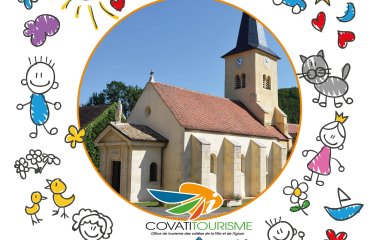En quelques mots
Dans la vallée de l'Ignon, le village de Moloy vous invite à arpenter ses nombreuses ruelles et à découvrir des monuments et des bâtisses chargées d'histoire : maisons du XVIe siècle, maisons fortes, fourneau et forges et église remarquable par ses peintures murales du début XVIe siècle. Visitez librement Moloy avec le parcours détaillé dans notre guide touristique. À découvrir en famille ! Un livret jeux est également disponible gratuitement à l'office de tourisme ou en téléchargement sur notre site.
Discover Moloy through nine historical points :
The Monument place is a memorial for the World War I symbolized by a French soldier (“poilu”).
Forge and furnace have been existing in Moloy since the 16th C. The last furnace worked until 1860.
4 rue de la Chapelle : This house from the 16th C, maybe was belonging to the abbot of Saint-Seine.
L’Église Saint-Jean-Baptiste : The church was built and restored from the 12th to the 17th C. Mural painting from the 16th C.
A source is situated at the end of the “Impasse de la Fontaine”. The legend tells that Henri IV drunk the water of the source after his victory in Fontaine-Française. A corner of the castle is visible behind the watercress bed.
The castle from the 19th C is situated on stronghold which belonging to the abbot of Saint Seine who were the Lord of Moloy.
1 rue Saint-Antoine : This house is a « châtillonnaise » house from the 16th C, characterized by a square tower, an external staircase and a wooden balustrade.
5 rue des Landes : “Châtillonnaise” house from the 16th C.
6 Grande Rue : Louis XIV in 1674 stayed in this house (number 6 of the Grande Rue street). To remember his stay some fleur de lys has been etch. This symbol was destroy during the French Revolution.
Discover Moloy through nine historical points :
The Monument place is a memorial for the World War I symbolized by a French soldier (“poilu”).
Forge and furnace have been existing in Moloy since the 16th C. The last furnace worked until 1860.
4 rue de la Chapelle : This house from the 16th C, maybe was belonging to the abbot of Saint-Seine.
L’Église Saint-Jean-Baptiste : The church was built and restored from the 12th to the 17th C. Mural painting from the 16th C.
A source is situated at the end of the “Impasse de la Fontaine”. The legend tells that Henri IV drunk the water of the source after his victory in Fontaine-Française. A corner of the castle is visible behind the watercress bed.
The castle from the 19th C is situated on stronghold which belonging to the abbot of Saint Seine who were the Lord of Moloy.
1 rue Saint-Antoine : This house is a « châtillonnaise » house from the 16th C, characterized by a square tower, an external staircase and a wooden balustrade.
5 rue des Landes : “Châtillonnaise” house from the 16th C.
6 Grande Rue : Louis XIV in 1674 stayed in this house (number 6 of the Grande Rue street). To remember his stay some fleur de lys has been etch. This symbol was destroy during the French Revolution.







